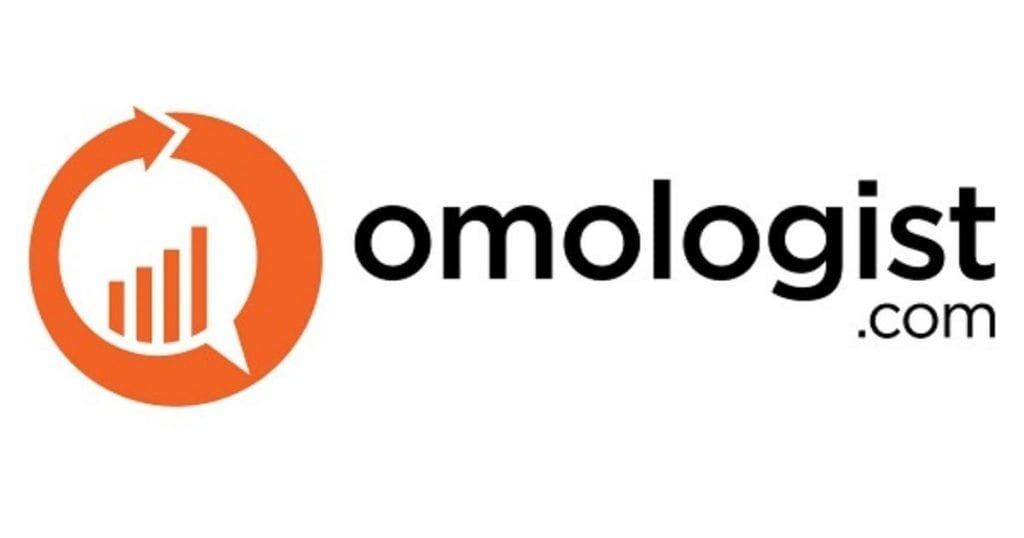What is a Call to Action (CTA)?
Definition and Purpose of a CTA
Before we dive into the nitty-gritty of CTAs, let’s break down the concept in simple terms. A call-to-action (CTA) is a message that encourages your audience to take a specific action, usually presented as a button, link, or simple short phrase. The primary purpose of a CTA is to guide users towards a desired outcome, whether it’s signing up for your newsletter, downloading a free eBook, or making a purchase.
Think of it as a gentle nudge to your readers, urging them to take the next step in their journey with your brand. CTAs are the secret sauce that can turn passive observers into active participants, ultimately helping you achieve your marketing and business goals too.
FYI – we will use a number of examples from designers on Canva in the article below. We don’t get any commission, but their designs help us provide examples and visually explain the concepts, so if you like their designs, we have included their links below each example.
Table of Contents
Types and Formats of CTAs
There are various types of CTAs, each serving a unique purpose depending on the action they prompt. Let’s explore some common types and their corresponding formats – examples are templates from Canva.com
1. Lead Generation CTAs
These CTAs are designed to capture leads by encouraging users to provide their contact information, usually in exchange for valuable content like eBooks, whitepapers, or webinars. Examples include “Download our eBook,” “Sign up for our free webinar now,” or “Get your free trial.”

If you like this design, see https://www.canva.com/p/mzlnteam/
2. Sales CTAs
The primary goal of these CTAs is to drive sales by persuading potential customers to purchase. Examples include “Add to Cart,” “Buy Now,” or “Upgrade Now.”

This design by https://www.canva.com/p/brightdesignse/
3. Subscription CTAs
These CTAs focus on building your email list by inviting users to subscribe to your newsletter or blog updates. Examples include “Subscribe Now,” “Join our mailing list,” or “Get weekly updates.”

This template by https://www.canva.com/p/graphicook/
4. Social Sharing CTAs
These CTAs encourage users to share your content on their social media profiles, increasing your brand’s visibility. Examples include “Share on Facebook,” “Tweet This,” or “Pin it.”
CTAs can appear in various formats depending on the medium they’re presented on:
– Button: A visually appealing and clickable element, often used for sales, subscription, or lead generation CTAs an ecommerce site. Example: “Buy Now” button on an eCommerce website.
– Link: A text hyperlink often used in blog posts or email marketing campaigns. Example: “Click here to download our free eBook.”
– Image: A clickable image, often used on social media platforms or in display ads. Example: A banner ad with an embedded “Shop Now” CTA or CTA button.
– Text: A simple text phrase often used for subtle prompts in content and digital marketing and pieces. Example: “Interested in learning more? Contact us today.”
By understanding the various types and formats of CTAs, you can better tailor your approach to suit your marketing objectives and audience preferences.
Understanding Call-to-Action (CTA) in Marketing
The Importance of CTAs in Marketing
CTAs play a pivotal role in marketing as they help guide your audience through the buyer’s journey, generate leads, increase conversions, and build relationships. By prompting your audience to take action, CTAs can effectively move them from one stage of the sales funnel to the next, ultimately leading to a higher likelihood of conversion.
Moreover, CTAs help bridge the gap between your content and the desired action, making it easy for users to understand what you want them to do. This clarity is crucial in establishing trust and building long-term relationships with your audience.
Crafting a CTA that Aligns with Marketing Goals and Audience Needs
To write a CTA that resonates with your audience and aligns with your marketing goals, consider the following:
1. Know your audience: Understand their preferences, pain points, and expectations to create a CTA that speaks to their needs.
2. Define your marketing goal: Identify the primary purpose of your CTA, whether it’s lead generation, sales, or social sharing, and create a message that aligns with that goal.
3. Keep it simple and clear: Use concise, actionable text–oriented language that tells your audience exactly what you want them to do.
4. Create a sense of urgency: Encourage immediate action by using time-sensitive language or offering limited-time incentives.
The AIDA Model for Crafting Effective CTAs
The AIDA model (Attention, Interest, Desire, Action) is a valuable framework for crafting CTAs that capture attention, spark interest, create desire, and prompt action.
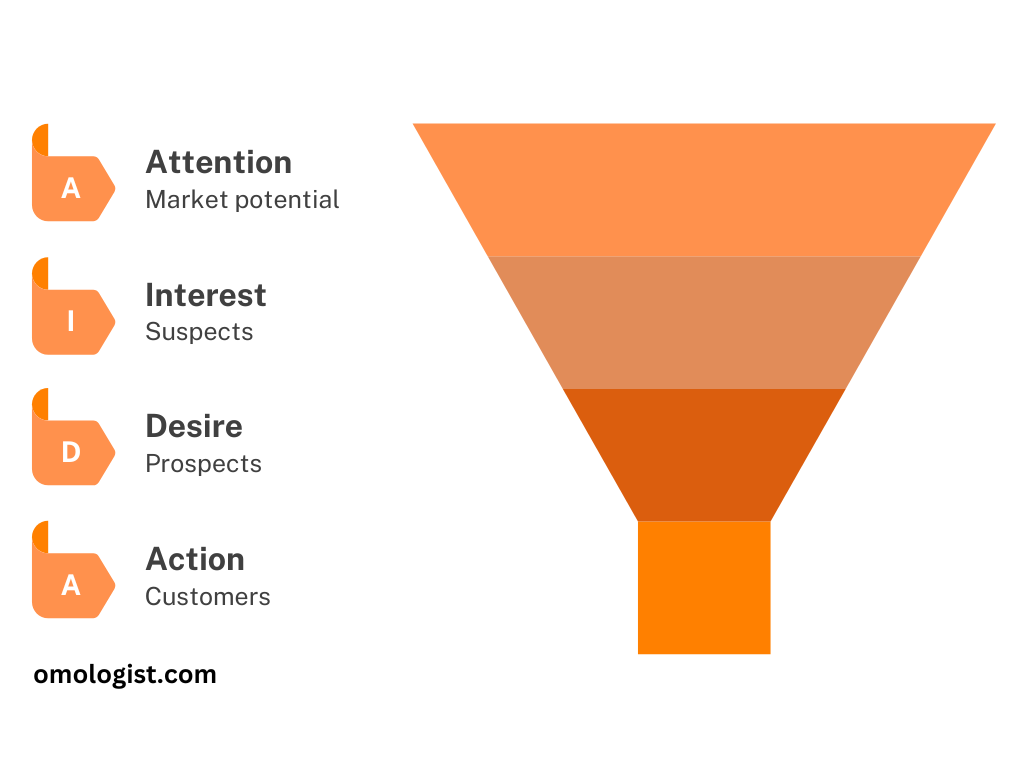
AIDA Model – attention, Interest, desire and action
1. Attention: Use eye-catching visuals or powerful headlines to grab your audience’s attention and make them aware of your CTA.
2. Interest: Present compelling information that highlights the benefits of taking the desired action, sparking curiosity and interest in your offer.
3. Desire: Foster a strong emotional connection by demonstrating how your offer can solve a problem or satisfy a need, creating a sense of desire.
4. Action: Clearly convey the desired action using action-oriented language and make it easy for users to take the next step, whether clicking a button or following a link.
By applying the AIDA model to your CTAs, you can create persuasive, goal-oriented messages that effectively prompt your audience to take action.
CTA Strategies
Creating effective calls-to-action (CTAs) is crucial for the success of your marketing campaigns. One key aspect of crafting compelling CTAs is strong action words. Let’s dive into the importance of action words and how to choose the right ones for your CTAs.
Use Strong Action Words
Action words are verbs that describe what the audience should do after reading your CTA. These words play a vital role in creating a sense of urgency, clarity, and motivation, ultimately driving your audience to take the desired action.
Choosing Strong Action Words for Your CTAs
To select the right action words for your CTAs, consider the following factors:
1. Marketing goal: Align your action words with your marketing objective, whether it’s generating leads, driving sales, or increasing engagement.
2. Audience: Tailor your action words to resonate with your target audience, addressing their needs and preferences.
3. Offer: Choose action words that accurately represent the benefit and value of your offer, making it more appealing to your audience.
Tips for Using Specific, Direct, and Positive Action Words
– Be specific: Use clear, concise verbs that leave no room for ambiguity or confusion.
– Be direct: Opt for straightforward action words that tell your audience exactly what they need to do.
– Be positive: Choose action words that convey the benefits and value of your offer, creating a positive perception.
Examples of Action Words and Their Use in CTAs
Don’t forget you can use a CTA button as well as in the text
– Buy: Buy now and get free shipping
– Order: Order today and receive a 10% discount
– Shop: Shop our latest collection and save big
– Subscribe: Subscribe to our newsletter and get exclusive offers
– Sign up: Sign up for our webinar and learn from the experts
– Join: Join our community and connect with like-minded people
– Register: Register for our online course and get certified
– Download: Download our eBook and discover the secrets of success
– Claim: Claim your free trial and see the difference
– Get: Get your personalized report and improve your performance
– Start: Start your journey and achieve your goals
– Try: Try our product and experience the benefits
– Learn: Learn more about our services and how we can help you
– Discover: Discover our amazing features and why you need them
– Explore: Explore our portfolio and see what we can do for you
– Find out: Find out how you can save money and time with us
– See: See how we helped our clients and what they say about us
– Watch: Watch our video and get inspired
– Read: Read our blog and get valuable insights
– Listen: Listen to our podcast and get entertained
– Share: Share this post and spread the word
– Follow: Follow us on social media and stay updated
– Like: Like this page and show your support
– Comment: Comment below and let us know what you think
– Donate: Donate now and make a difference
– Support: Support our cause and join our movement
– Contact: Contact us today and get a free consultation
– Call: Call us now and speak to a friendly representative
– : Email us your questions, and we’ll get back to you soon
– Chat: Chat with us live and get instant answers

If you like this design, find more at https://www.canva.com/p/calang/
By incorporating strong action words in your CTAs, you can effectively motivate your audience to take the desired action, ultimately driving better results for your marketing campaigns.
How to Avoid Weak or Negative Action Words for Your CTAs
Using weak or negative action words in your CTAs can reduce the impact and effectiveness of your message, making it less persuasive and engaging. To ensure your CTAs deliver the desired results, follow these guidelines to avoid weak or negative action words:
1. Avoid passive voice: Passive voice can make your CTA sound less direct and less compelling. Instead, use an active voice to create a more engaging and persuasive tone. For example, instead of “The form should be submitted by you,” use “Submit the form.”
2. Steer clear of vague words: Vague words can create confusion and ambiguity, diminishing the effectiveness of your CTA. Choose clear, specific, and concise words that communicate your message effectively. For example, instead of “Try our stuff,” use “Try our skincare products.”
3. Bypass words that imply risk or obligation: Using words that suggest risk, obligation, or commitment can deter your audience from taking action. Opt for words that create a sense of excitement, opportunity, or reward. For example, instead of “Invest in our course,” use “Unlock the secrets of our course.”
Examples of Weak or Negative Action Words
– Submit: Instead of “Submit your email,” use “Join our mailing list.”
– Enter: Instead of “Enter our competition,” use “Participate in our competition.”
– Try: Instead of “Try our services,” use “Experience our top-rated services.”
– Maybe: Instead of “Maybe you’ll like this offer,” use “You’ll love this offer.”
– Click here: Instead of “Click here to learn more,” use “Discover more now.”
By avoiding weak or negative action words, you can craft more persuasive and effective CTAs that inspire your audience to take the desired action, ultimately driving better results for your marketing campaigns.
Evoke an Emotional Response
An emotional response refers to the feeling or reaction your audience experiences after reading your CTA. Evoking an emotional response is crucial for creating effective CTAs, as it helps you connect with your audience, influence their decision-making, and increase their engagement.
Importance of Emotional Response for CTAs
– Connect with the audience: Emotionally-charged CTAs create a sense of relatability and resonance, helping to establish a stronger bond with your audience.
– Influence decision-making: Emotions play a significant role in the decision-making process. By appealing to your audience’s emotions, you can encourage them to take the desired action.
– Increase engagement: Emotional CTAs can capture your audience’s attention and spark curiosity, ultimately driving higher engagement and conversions.
Evoking an Emotional Response Based on Marketing Goal, Audience, and Offer
To evoke an emotional response in your CTAs, consider the following factors:
1. Marketing goal: Align the emotional trigger with your marketing objective, whether it’s generating leads, driving sales, or increasing customer engagement.
2. Audience: Understand your target audience’s preferences, pain points, aspirations, fears, or desires to create an emotional connection.
3. Offer: Use emotional triggers that accurately represent the benefit and value of your offer, making it more appealing to your audience.
Using Emotional Triggers to Appeal to Your Audience’s Emotions
Leverage emotional triggers such as pain points, aspirations, fears, or desires to create a stronger connection with your audience. By addressing these triggers, you can create a compelling and effective CTA that drives action.
Examples of CTAs that Evoke Emotional Responses
– Don’t miss this opportunity: Don’t miss this opportunity to get your dream job
– Yes, I want it: Yes, I want it! Send me the free ebook now
– Join the revolution: Join the revolution and become a part of history
– Save a life: Save a life today by donating blood
– Be the first to know: Be the first to know when we launch our new product
– Imagine if: Imagine if you could travel the world without any worries
– What are you waiting for?: What are you waiting for? Claim your free trial now
– Don’t let them win: Don’t let them win. Fight for your rights
– Hurry, limited time offer: Hurry, limited time offer! Get 50% off before it’s too late
– You deserve this: You deserve this. Treat yourself to a relaxing spa day
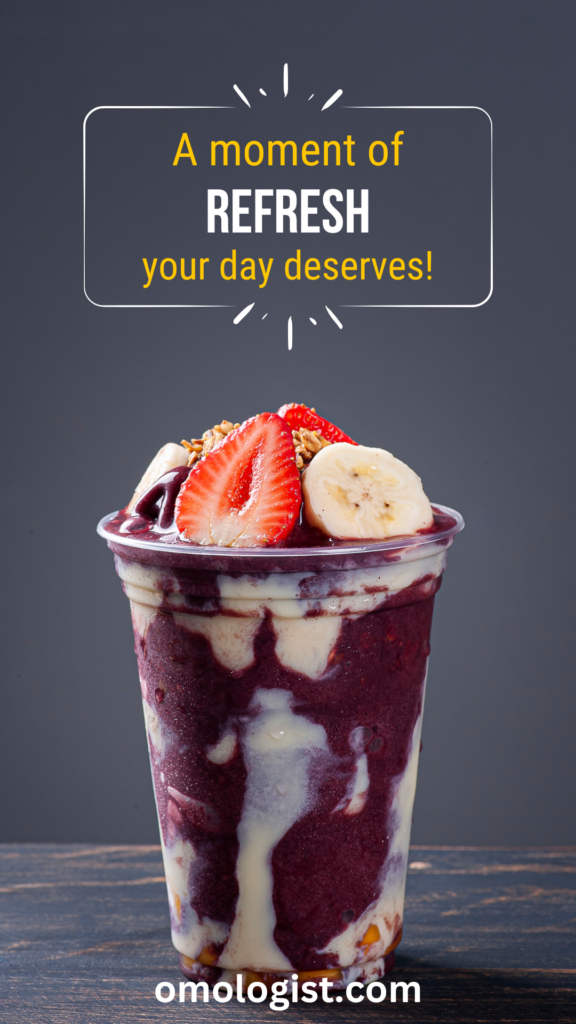
If you like this design, find more at https://www.canva.com/p/jetozanini/
By evoking an emotional response in your CTAs; you can create a more powerful connection with your audience, ultimately leading to better results for your marketing campaigns.
How to Avoid Overdoing or Misusing an Emotional Response for Your CTAs
While emotional responses can be powerful in CTAs, overdoing or misusing them can backfire and damage your reputation. To ensure that you strike the right balance, follow these guidelines:
1. Keep it genuine: Craft CTAs that genuinely connect with your audience’s emotions, without resorting to exaggerated or manipulative tactics. Be transparent and honest in your messaging, and avoid overpromising or using misleading claims.
2. Respect your audience’s emotions: Be sensitive to your audience’s feelings and avoid exploiting their emotions for your benefit. Consider the potential impact of your messaging on your audience, and steer clear of CTAs that could alienate or offend them.
3. Maintain brand consistency: Ensure that your emotionally-charged CTAs align with your overall brand tone and voice. Avoid using emotional triggers that contradict your brand values or positioning, which can confuse or disillusion your audience.
Examples of CTAs That Overdo or Misuse an Emotional Response
– Anger: “You’ll be furious if you miss out on this offer!” – This CTA uses anger in an exaggerated and manipulative way, which can deter potential customers.
– Guilt: “Don’t you care about the environment? Buy our eco-friendly products now!” – This CTA exploits the audience’s guilt, potentially alienating them.
– Shame: “You’ll be the laughingstock if you don’t take advantage of our sale!” – This CTA uses shame as a tactic, which can be offensive and counterproductive.
By carefully crafting your CTAs and avoiding the overuse or misuse of emotional responses, you can create compelling and effective messages that drive results while maintaining your brand’s integrity and reputation.
Include no-obligation statements
Including no-obligation statements in your CTAs can significantly reduce your audience’s hesitation, anxiety, or resistance when taking the desired action. Here’s how to effectively include no-obligation statements in your CTAs:
Align with your marketing goal, audience, and offer
Choose no-obligation statements that resonate with your target audience and support your marketing goals. For example, if your goal is to generate leads, use a no-obligation statement that emphasizes the ease of signing up.
Use words or phrases that imply freedom, flexibility, or security
Select phrases such as “free,” “cancel anytime,” “no strings attached,” and “risk-free” to reassure your audience that they can take action without feeling pressured or committed.
Avoid too many or too weak no-obligation statements
Including too many no-obligation statements can dilute or undermine your message. Additionally, using words or phrases that imply doubt or uncertainty can make your CTA less convincing. Stick to one or two strong no-obligation statements that effectively communicate your offer’s value and low risk.
Stay truthful and transparent
Ensure that your no-obligation statements are accurate and not misleading. False or exaggerated claims can lead to negative consequences, such as violating legal regulations or damaging your audience’s trust.
Example CTAs for no-obligation statements
Here are some examples of effective no-obligation statements in CTAs:
– Try it for free (Try it for free for 30 days and see the difference)
– No credit card required (No credit card required. Sign up today and get access to all features)
– Cancel anytime (Cancel anytime. No questions asked)
– Money-back guarantee (Money-back guarantee. If you’re not satisfied, we’ll refund you)
– No strings attached (No strings attached. Get your free sample now)
– Risk-free trial (Risk-free trial. You have nothing to lose)
– No commitment required (No commitment required. You can opt out anytime)
– Free consultation (Free consultation. No obligation to buy)
– No hidden fees (No hidden fees. What you see is what you pay)
– No pressure (No pressure. Just fill out this form, and we’ll get back to you soon)

If you like this design, find more at https://www.canva.com/p/alitstudio/
Avoid misleading or false statements that violate your audience’s expectations or legal regulations. By incorporating strong, accurate, no-obligation statements in your CTAs, you can boost engagement and conversions by reducing your audience’s hesitation and anxiety.
Customize your CTA for your audience and goal
CTA customization is the process of tailoring your call-to-action (CTA) to suit the specific needs, preferences, and behaviours of your target audience. Customizing your CTA helps increase the relevance, personalization, and effectiveness of your marketing message, leading to higher engagement and conversion rates.
The importance of effective CTA customization lies in its ability to make your message more relatable and compelling to your target audience. By understanding your audience’s characteristics, you can craft CTAs that resonate with them and prompt them to take the desired action.
To customize your CTA based on your audience’s characteristics, consider the following:
1. Demographics: Consider age, gender, income, and education when crafting your CTA. Different demographics may respond better to different language styles or offers.
2. Psychographics: Take into account your audience’s interests, values, attitudes, and lifestyles. This helps you create a CTA that appeals to their motivations and beliefs.
3. Behaviour: Understand your audience’s online behaviour, such as browsing habits, preferred channels, and past interactions with your brand. This allows you to tailor your CTA to fit their preferences and needs.
Using segmentation, targeting, and positioning strategies can help you identify and reach your ideal audience segments:
1. Segmentation: Divide your audience into smaller groups based on their shared characteristics, such as demographics, psychographics, or behaviour.
2. Targeting: Select the segments that are most relevant and valuable to your marketing goals, and focus your efforts on reaching them.
3. Positioning: Craft a unique and appealing value proposition for each target segment, and communicate it effectively through your CTA.
Example CTAs for different audience types
Here are some examples of customized CTAs for different audience types:
– For a young and tech-savvy audience: “Swipe right to get started” or “Tap here to join the fun”.
– For a professional and busy audience: “Schedule a call now” or “Download the report in one click”.
– For a curious and eager-to-learn audience: “Find out how it works” or “Learn from the experts”.
– For an emotional and passionate audience: “Make a difference today” or “Live your dream life”.
– For a sceptical and cautious audience: “See what others are saying” or “Try it risk-free”.
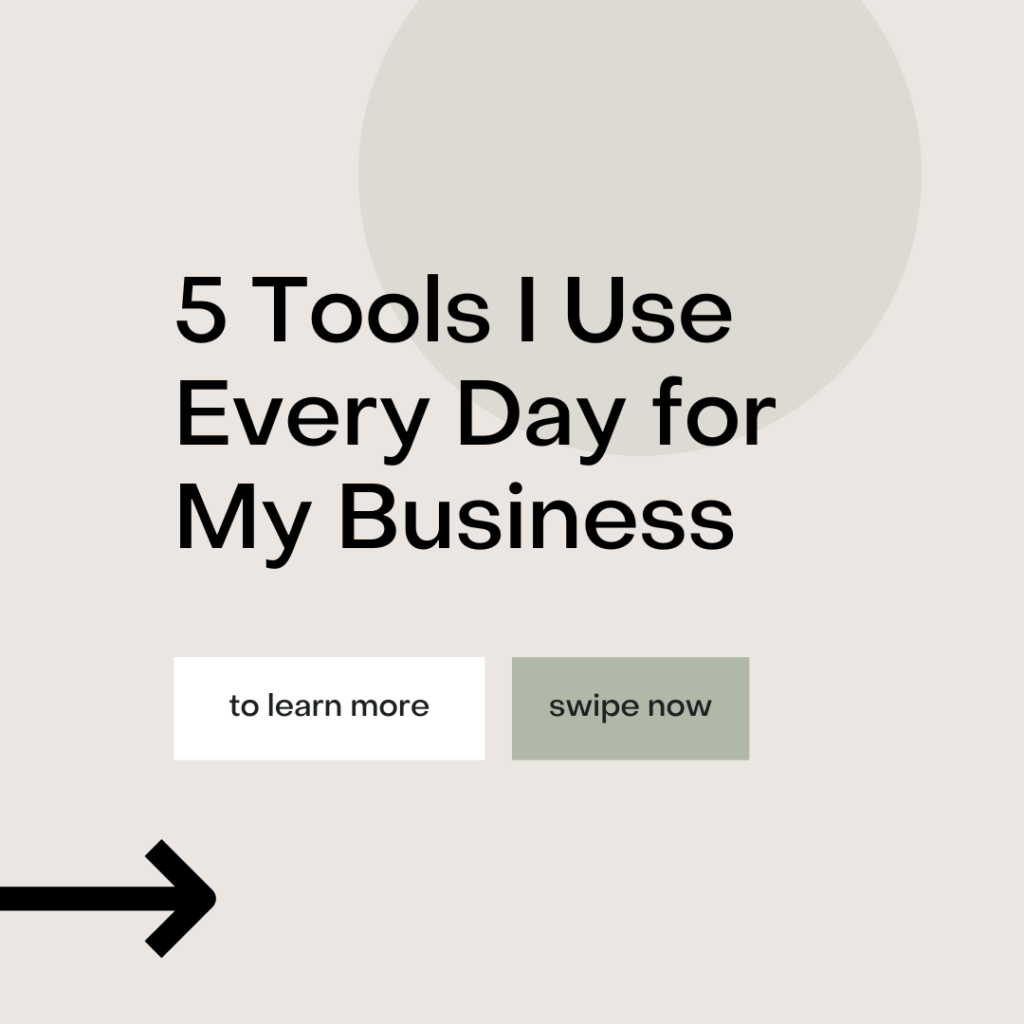
If you like this design, check out https://www.canva.com/p/mysocialdesigner/
By customizing your CTA based on your audience’s characteristics and your marketing goals, you can create more impactful and persuasive messages that drive engagement and conversions.
Customizing your CTA based on your audience’s stage in the buyer’s journey helps ensure your message aligns with their needs and interests at each step. This increases the likelihood of engagement and conversion. The buyer’s journey typically consists of three stages: awareness, consideration, and decision.
Awareness stage: At this stage, buyers become aware of a problem or need and start searching for information or solutions. Your CTA should offer valuable, relevant content that helps them better understand their situation.
Examples:
– “Learn how to improve your productivity”
– “Discover the best practices for email marketing”
Consideration stage: Buyers have now defined their problem or need and are evaluating different options. Your CTA should provide specific, persuasive content that demonstrates how your product or service can address their needs.
CTA Examples:
– “Get your free trial today”
– “Save 50% off your first month”
Decision stage: Buyers have chosen their preferred option and are ready to make a purchase. Your CTA should offer incentives that motivate them to act immediately, removing any remaining doubts or objections.
CTA Examples:
– “Buy now and get a free gift”
– “Order today and receive free shipping”
To guide your audience through the buyer’s journey, use a combination of content marketing, lead nurturing, and sales funnel strategies:
1. Content marketing: Create and distribute valuable, relevant content tailored to each stage of the buyer’s buying journey. This helps attract, engage, and retain your target audience, building trust and credibility.
2. Lead nurturing: Implement targeted marketing campaigns designed to engage leads at each stage of the buyer’s journey, providing them with the information and resources they need to move forward. This can include personalized emails, social media messages, and retargeting ads.
3. Sales funnel: Design your sales funnel to guide leads through the buyer’s journey, from awareness to decision, using a combination of content, calls-to-action, and conversion points. Monitor and analyze your funnel’s performance to optimize it for better results.
By aligning your CTAs with the stage of the buyer’s journey, you can create more relevant and compelling messages that resonate with your audience and drive them to take action.
Align your CTA with your marketing goal
Call to action alignment refers to the process of ensuring that your call-to-action (CTA) corresponds with your marketing goal and offer. Aligning your call to action with your marketing goal is essential because it creates a clear, consistent, and coherent message for your audience, increasing the chances of engagement and conversion.
The importance of the call to action alignment lies in its ability to:
– Maintain a strong connection between your marketing goal and the desired action
– Create a cohesive user experience that guides the audience towards taking the desired action
– Enhance the effectiveness of your marketing campaigns
How to align your call to action with your marketing goal
To align your call to action with your marketing goals, such as brand awareness, lead generation, sales conversion, or customer retention, follow these steps:
1. Identify your marketing goal: Determine the primary objective of your marketing campaign using SMART (Specific, Measurable, Achievable, Relevant, Time-bound) criteria. This helps you create a focused and realistic goal that can guide your call to action strategy.
2. Design your compelling call to action: Craft a compelling and effective call to action that clearly communicates the desired action related to your marketing goal. Ensure that the call to action is concise, actionable, and compelling to encourage your audience to engage with it.
3. Test and optimise: Monitor the performance of your call to action and gather data to analyze its effectiveness. Use this information to optimize your call to action for better alignment with your marketing goal.
Examples of CTAs aligned with different marketing goals
1. Brand awareness: CTAs are marketing materials that aim to increase the visibility and recognition of your brand.
– “Follow us on social media”
– “Subscribe to our newsletter”
2. Lead generation: CTAs that focus on capturing contact information or encouraging prospects to express interest in your product or service.
– “Download our free ebook”
– “Sign up for a webinar”
3. Sales conversion: CTAs that drive prospects towards making a purchase or committing to your product or service.
– “Shop now”
– “Get started with a free trial”
4. Customer retention: CTAs that foster loyalty, engagement, and repeat business from existing and prospective customers.
– “Refer a friend and get a discount”
– “Join our loyalty program”
By aligning your call to action with your marketing goal, you ensure that your message remains focused and relevant, leading to higher conversion rates and a more successful marketing campaign.
Examples add some of these to the text above if missing
- If your marketing goal is to generate leads, you might use a CTA that offers a valuable resource or incentive in exchange for contact information, such as “Download our free guide” or “Get your free quote”.
- If your marketing goal is to increase sales, you might use a CTA that encourages a purchase decision or upsells a product or service, such as “Buy now and save 20%” or “Upgrade to premium”.
- If your marketing goal is to build brand awareness, you might use a CTA that promotes social sharing or referrals, such as “Share this post with your friends” or “Invite a friend and get a reward”.
- If your marketing goal is to improve customer retention, you might use a CTA that fosters loyalty or engagement, such as “Renew your subscription” or “Leave a review”.
- If your marketing goal is to drive traffic, you might use a CTA that attracts attention or curiosity, such as “Click here to learn more” or “See what’s new”.
Leveraging psychology in CTAs, such as curiosity, problem-solution approach, and the urge to belong
Psychology is the scientific study of human behaviour and mental processes, and it plays a crucial role in crafting effective CTAs. Understanding the psychological principles that drive human actions can help marketers create compelling CTAs that resonate with their audience and influence their motivations, emotions, and decisions.
How to leverage curiosity in your CTAs
Curiosity is a psychological trigger that drives people to seek new information or experiences. By leveraging curiosity, you can capture your audience’s attention and motivate them to take action. Here’s how to use curiosity in your CTAs:
1. Open loops: Create an incomplete narrative or story that compels the audience to seek closure by clicking on your CTA. For example, “You’ll never guess what happened next…”
2. Questions: Pose an intriguing question that encourages the audience to find the answer through your CTA. For example, “Do you know the secret to doubling your productivity?”
3. Teasers: Offer a glimpse or hint of valuable information, enticing the audience to the clickable button on your CTA to learn more. For example, “Discover the little-known technique that will boost your sales.”
4. Surprises: Promise an unexpected revelation or benefit that will pique the audience’s interest. For example, “Uncover the hidden truth behind successful marketing.”
Examples of CTAs that leverage curiosity
1. “Find out how you can lose weight without dieting or exercise.”
2. “Discover the secret to a stress-free life.”
3. “See what happens next when you try our revolutionary product.”
4. “Unlock the mystery behind effective communication.”
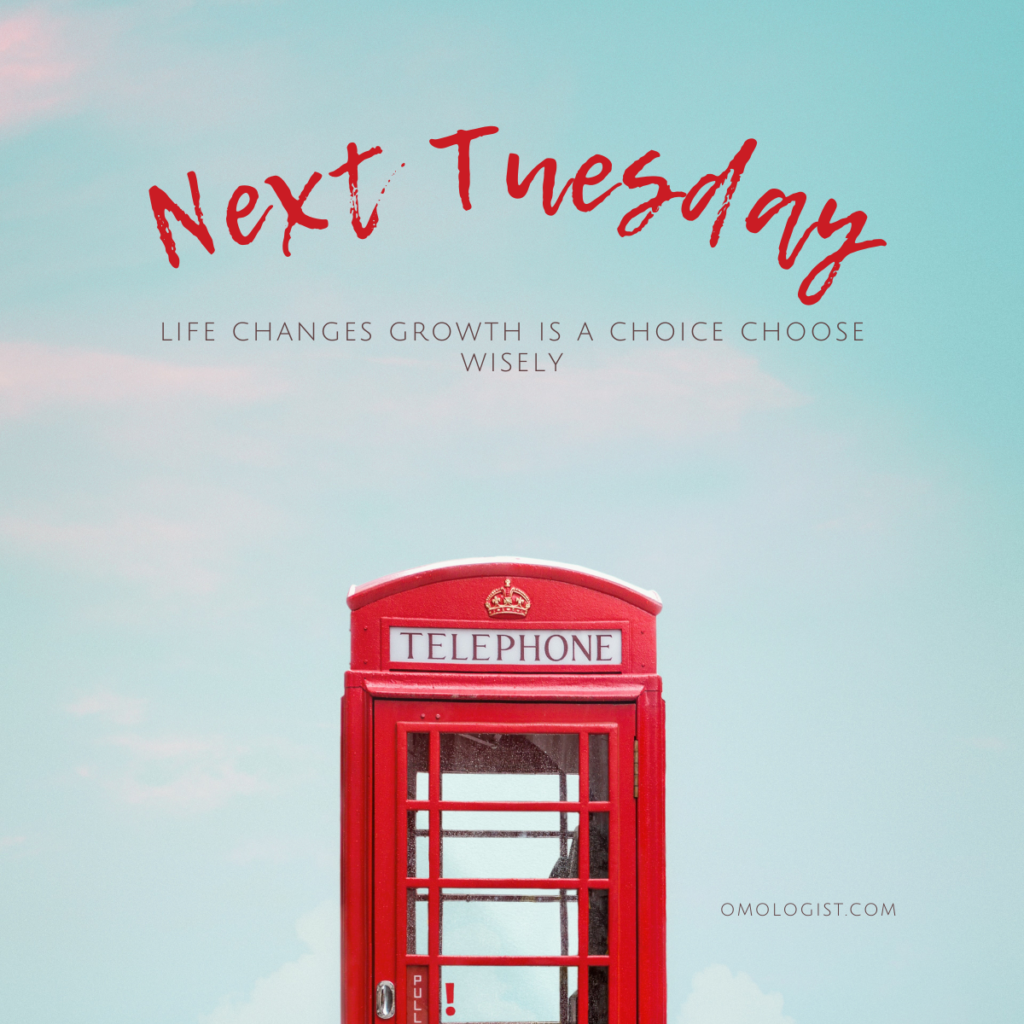
If you like this design, check out https://www.canva.com/p/yellowglasium/
By leveraging curiosity in your CTAs, you can create a strong desire in your audience to learn more or engage with your offer. This can lead to higher click-through rates and better overall campaign performance.
How to leverage the problem-solution approach in your CTAs
The problem-solution approach is a psychological framework that helps the audience identify and overcome their pain points or challenges. By presenting a clear problem and offering a solution, you can demonstrate the value of your product or service, making your CTA more compelling. Here’s how to use the problem-solution approach in your CTAs:
1. Agitate-solve: First, emphasize the audience’s pain point to create a sense of urgency or frustration. Then, present your product or service as the solution to alleviate their pain. For example, “Tired of your slow computer? Speed it up with our software.”
2. Before-after: Show the transformation your product or service can bring to your audience’s life, highlighting the difference between their current situation and the improved one they could experience. For example, “Go from cluttered to organized with our storage solutions.”
3. Features-benefits: Explain how the features of your product or service translate into tangible benefits that address your audience’s pain points. For example, “Our energy-efficient light bulbs save you money on your electric bill.”
Examples of CTAs that leverage the problem-solution approach
1. “Stop wasting time on manual data entry. Automate your processes today.”
2. “Get rid of stress and sleep better with our mindfulness app.”
3. “Achieve your fitness goals with our personalized workout plans.”
4. “Say goodbye to bad hair days with our salon-quality products.”

If you like this design, see https://www.canva.com/p/tplatestudio/
Using the problem-solution approach in your CTAs, you can effectively tap into your audience’s needs and desires, making your offers more enticing and relevant. This approach increases the likelihood of your audience taking the desired action and helps improve overall campaign performance.
How to leverage the urge to belong in your CTAs
The urge to belong is a psychological need that drives the audience to seek social connection and acceptance. People are naturally drawn to be part of groups or communities where they feel a sense of belonging. By tapping into this need, you can create compelling CTAs that resonate with your audience. Here’s how:
1. Social proof: Showcase the number of users, customers, or followers your product or service has to create a sense of popularity and trust. For example, “Join over 10,000 satisfied customers who trust our software.”
2. Testimonials: Share positive reviews, ratings, or stories from satisfied customers to build credibility and demonstrate that others have benefited from your product or service. For example, “See what our happy customers say about their experience.”
3. Community: Emphasize the community or group your audience can join or become a part of by engaging with your product or service. For example, “Join our fitness community and get the support you need to reach your goals.”
Examples of CTAs that leverage the urge to belong
1. “Join the club and get exclusive access to member-only deals.”
2. “Be part of something bigger. Support our cause and make a difference today.”
3. “See what others are saying about our life-changing program.”
4. “Become a member and connect with like-minded individuals.”
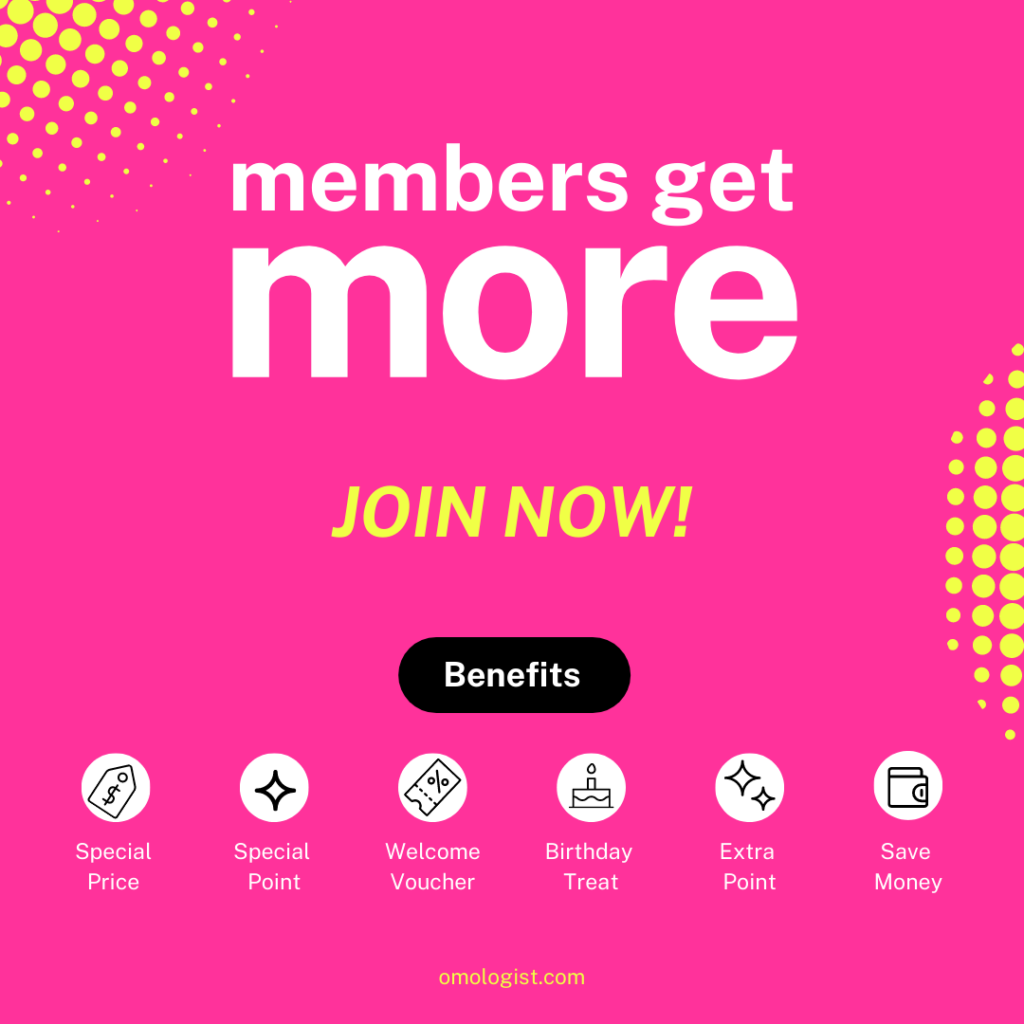
If you like this design, check out https://www.canva.com/p/selesa/
By leveraging the urge to belong in your CTAs, you can create a strong emotional connection with your audience and encourage them to take action. People are more likely to engage with your product or service when they feel they are joining a community or movement that aligns with their values, needs, or interests.
Provoke Emotion or Enthusiasm
One of the most powerful ways to make your CTAs more effective is by provoking emotion or enthusiasm. Emotions play a crucial role in decision-making, and by creating a positive feeling or reaction in your audience, you can boost their interest, engagement, and loyalty towards your brand.
How to provoke emotion or enthusiasm in your CTAs
To provoke emotion or enthusiasm in your CTAs, consider your marketing goal, audience, and offer. Use storytelling, humour, or excitement to make your message more appealing and engaging. For instance, use powerful, action-oriented words that evoke a sense of curiosity or urgency.
Some examples of CTAs that provoke emotion or enthusiasm include:
– Start your adventure “Start your adventure with our exciting travel packages”)
– Laugh out loud “Laugh out loud with our collection of comedy podcasts”)
– Don’t miss this opportunity “Don’t miss this opportunity to save on our best-selling products”)
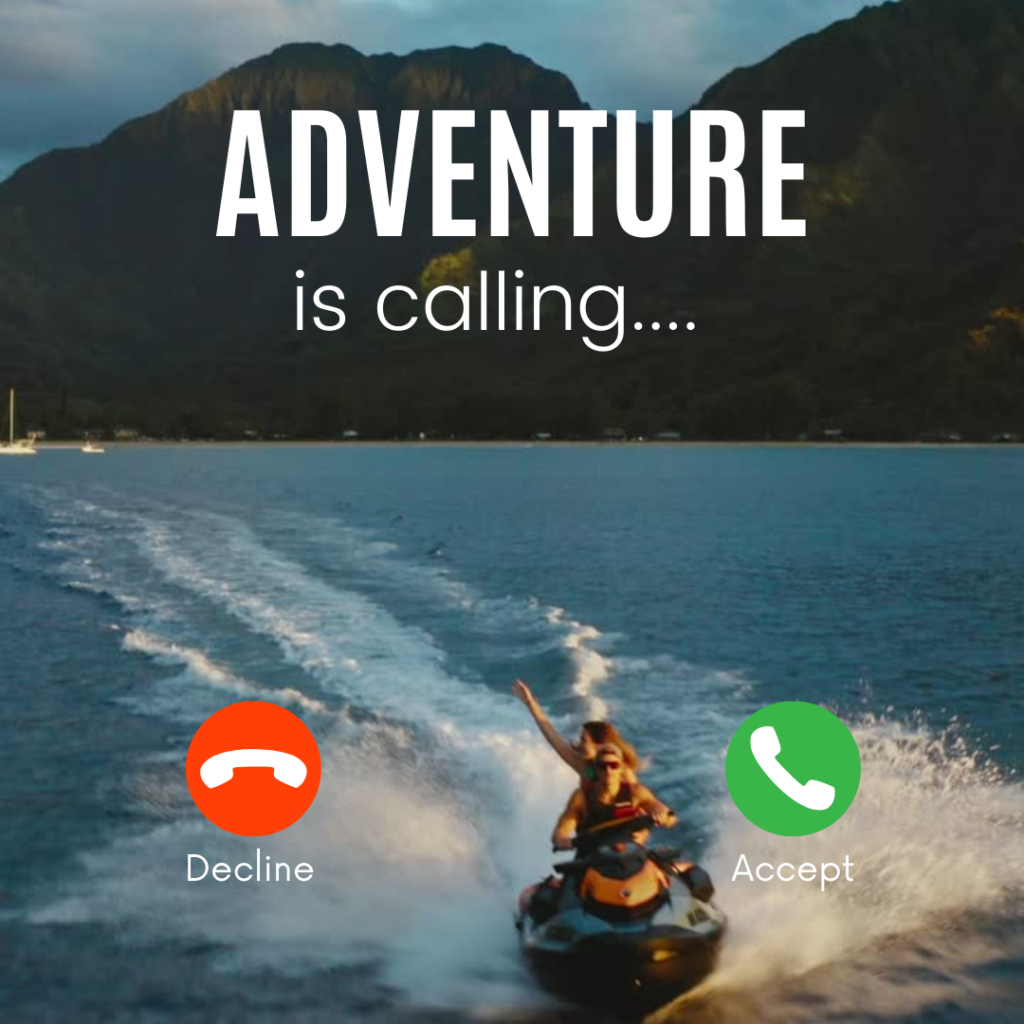
If you like the design, see https://www.canva.com/p/heenasheikh/
How to avoid overdoing or misusing emotion or enthusiasm in your CTAs
While emotion and enthusiasm are powerful tools, they can backfire if overdone or misused. Avoid exaggeration, hype, or false promises, as these can create unrealistic expectations or breed distrust in your CTAs.
Some examples of CTAs that overdo or misuse emotion or enthusiasm include:
– This will change your life “This one simple trick will change your life forever”)
– You won’t believe this “You won’t believe the results from our revolutionary weight loss system”)
– Act now or regret later “Act now or regret missing out on these limited-time discounts”)
By striking the right balance between provoking emotion and maintaining credibility, you can create CTAs that resonate with your audience and drive the desired action.
CTA Examples of well-crafted, emotion-provoking:
– Snuggle up “Snuggle up to Headspace and enjoy a relaxing meditation session”
– Dream big “Dream big and achieve your goals with our coaching program”
– Spoil yourself “Spoil yourself with our luxurious spa treatments”
– Crush it “Crush it with our high-intensity workout plan”
– Wow “Wow your guests with our delicious catering service”
– Love “Love your skin with our natural beauty products”
– Laugh “Laugh out loud with our hilarious comedy show”
– Surprise “Surprise your loved ones with our personalised gifts”
– Thrill “Thrill your senses with our adventurous tours”
– Delight “Delight your taste buds with our mouthwatering recipes”

If you like this design, check out https://www.canva.com/p/radstylist/
Offer Something Valuable
Value is the perceived benefit or worth your audience gets from taking the desired action. Demonstrating value in your CTAs is essential, as it persuades your audience to take action by showing them what’s in it for them.
How to offer something valuable in your CTAs
To offer something valuable in your CTAs, consider your marketing goal, audience, and offer. Use incentives, discounts, bonuses, or guarantees to increase the value of your offer and make it more enticing.
Some examples of CTAs that offer something valuable include:
– Get a free ebook “Get a free ebook when you subscribe to our newsletter”)
– Save 20% “Save 20% on your first purchase with code WELCOME20”)
– Get a bonus gift “Get a bonus gift when you spend over $100”)
– Get your money back “Try our product risk-free with our 30-day money-back guarantee”)
How to avoid offering something worthless or irrelevant in your CTAs
To avoid offering something worthless or irrelevant in your CTAs, be mindful of the impact and effectiveness of your message. Steer clear of low-value offers, generic offers, or mismatched offers that can decrease your offer’s value.
Some examples of CTAs that offer something worthless or irrelevant include:
– Get a free quote “Get a free quote” without explaining the benefits or uniqueness of your service)
– Learn more “Learn more” without specifying what valuable information they will gain)
– See our products “See our products” without highlighting any unique features or benefits)
By offering something valuable and relevant, you can create CTAs that resonate with your audience and drive the desired action.
CTA Examples creating something valuable:
– Download “Download our free guide and learn how to master SEO”)
– Save “Save 50% off your first order when you sign up today”)
– Get “Get a free gift when you buy any of our products”)
– Guarantee “Guarantee your spot and register now for our exclusive event”)
– Solve “Solve your plumbing problems with our expert service”)
– Claim “Claim your free trial and see the difference for yourself”)
– Win “Win a chance to meet your favourite celebrity by entering our contest”)
– Access “Access our premium features and enjoy unlimited benefits”)
– Secure “Secure your spot and get early access to our new product”)
– Learn “Learn from the best and enrol in our online course”)

If you like the design, check out https://www.canva.com/p/emcrea/
Create a Sense of Urgency
Urgency is a psychological trigger that drives your audience to take the desired action quickly or immediately. Incorporating urgency in your CTAs is crucial to overcoming procrastination, indecision, or distraction.
How to create a sense of urgency in your CTAs
To create a sense of urgency in your CTAs, consider your marketing goal, audience, and offer. Use techniques such as deadlines, scarcity, or exclusivity to compel your audience to act quickly.
Some examples of CTAs that create a sense of urgency include:
– Act now “Act now to save 30% on your next purchase”)
– Limited time “Limited time offer: Save 15% when you book by Friday”)
– Only a few left “Only a few seats left for our exclusive workshop”)
How to avoid creating a sense of false or excessive urgency in your CTAs
Creating a sense of false or excessive urgency in your CTAs can backfire or damage your reputation. Avoid using fake countdowns, fake stock levels, or fake offers that can lead to distrust among your audience.
Some examples of CTAs that create a sense of false or excessive urgency include:
– Last chance “Last chance to save” when the offer is not genuinely ending)
– Don’t miss this “Don’t miss this sale” when the sale is recurring)
– Hurry up “Hurry up and buy” without a clear reason for urgency)
By creating a genuine sense of urgency and avoiding deceptive tactics, you can effectively motivate your audience to take action.
CTA Examples of urgent:
– Now “Buy now and get free shipping”)
– Today “Order today and receive a 10% discount”)
– Limited “Shop our limited edition collection before it’s gone”)
– Hurry “Hurry, this offer ends soon”)
– Last chance “Last chance to get your tickets for the concert”)
– Don’t miss “Don’t miss this opportunity to win a free trip”)
– Act fast “Act fast and claim your bonus”)
– Only “Only 5 spots left for our exclusive webinar”)
– While supplies last “While supplies last, get a free gift with every purchase”)
– Before it’s too late “Before it’s too late, enrol in our online course”)

If you like the design, check out https://www.canva.com/p/patimuniz/
FOMO – Fear of Missing Out
Fear of missing out (FOMO) is a psychological phenomenon that makes your audience feel anxious or regretful about missing out on something valuable or desirable. Incorporating FOMO in your CTAs can motivate your audience to take the desired action by creating a sense of scarcity, exclusivity, or social proof.
How to use fear of missing out in your CTAs
To use FOMO in your CTAs, consider your marketing goal, audience, and offer. Employ techniques such as limited time, limited stock, limited access, or testimonials to create FOMO in your CTAs.
Some examples of CTAs that use fear of missing out include:
– Don’t miss this deal “Don’t miss this deal: 30% off for a limited time”)
– Join the waitlist “Join the waitlist for early access to our new product”)
– See what others are saying “See what others are saying about our bestselling course”)
How to avoid using fear of missing out in a negative or unethical way in your CTAs
To avoid using FOMO in a negative or unethical way in your CTAs, be mindful of the techniques you use. Steer clear of false scarcity, false urgency, false social proof, or false promises that can damage your reputation or backfire.
Some examples of CTAs that use fear of missing out in a negative or unethical way include:
– Last chance ever “Last chance ever to get this discount” when the discount is recurring)
– You’ll regret this forever “You’ll regret not joining our course forever” when the course is not truly life-changing)
– Everyone is doing it “Everyone is buying our product” without valid social proof)
By using FOMO responsibly, you can effectively motivate your audience to take action.
CTA Examples of FOMO-driven:
– Don’t miss “Don’t miss this opportunity to win a free trip”)
– Only “Only 5 spots left for our exclusive webinar”)
– See what others are saying “See what others are saying about our product”)
– Limited “Limited time offer: get 50% off before it’s too late”)
– Be the first to know “Be the first to know when we launch our new product”)
– Join the revolution “Join the revolution and become a part of history”)
– Last chance “Last chance to get your tickets for the concert”)
– Don’t let them win “Don’t let them win. Fight for your rights”)
– Exclusive “Exclusive access: join our VIP club and enjoy unlimited benefits”)
– Act now or regret later “Act now or regret later. This is your chance to change your life”)

If you like the design, see https://www.canva.com/p/yganko/
Benefits
Benefits are the positive outcomes or results your audience can expect from taking the desired action. Emphasizing benefits in your CTAs can persuade your audience to act by showing them what’s in it for them.
How to use benefits in your CTAs
To use benefits in your CTAs effectively, consider your marketing goal, audience, and offer. Utilize techniques such as features-benefits, before-after, or problem-solution to highlight the benefits of your offer.
Some examples of CTAs that use benefits include:
– Save money “Save money with our energy-efficient appliances”)
– Get more leads “Get more leads with our powerful CRM”)
– Improve your health “Improve your health with our wellness program”)
How to avoid using vague or irrelevant benefits in your CTAs
To avoid using vague or irrelevant benefits in your CTAs, steer clear of generic claims, exaggerated promises, or mismatched benefits that can reduce the impact and effectiveness of your message.
Some examples of CTAs that use vague or irrelevant benefits include:
– Get better results “Get better results with our software” without specifying what kind of results)
– Be happier “Be happier with our product” without explaining how the product contributes to happiness)
– Achieve more “Achieve more with our program” without detailing what “more” entails)
CTA Examples that are benefit-focused:
– Improve “Improve your health and happiness with this simple trick”)
– Achieve “Achieve your goals with our coaching program”)
– Save “Save money and time with our fast and easy service”)
– Learn “Learn from the best and enrol in our online course”)
– Discover “Discover the secrets of success with our free ebook”)
– Experience “Experience the benefits of our product with a free trial”)
– Enjoy “Enjoy a relaxing spa day with our special offer”)
– Grow “Grow your business with our proven strategies”)
– Solve “Solve your plumbing problems with our expert service”)
– Transform “Transform your life with our amazing program”)

If you like the design, see https://www.canva.com/p/craftsmanart/
Numbers
Numbers are digits or symbols that represent quantities, values, or measurements. Using numbers in your CTAs can attract the audience’s attention, increase the credibility of your message, and quantify the value of your offer.
How to use numbers in your CTAs
To effectively use numbers in your CTAs, consider your marketing goal, audience, and offer. Use statistics, percentages, prices, or ratings to incorporate numbers in your CTAs.
Some examples of CTAs that use numbers include:
– Join 10,000+ subscribers “Join 10,000+ subscribers and receive weekly updates”)
– Save 50% “Save 50% on your first purchase”)
– Get a 5-star rating “Get a 5-star rating with our top-rated service”)
To avoid using misleading or confusing numbers in your CTAs, refrain from using false or outdated data, unclear or ambiguous units, or irrelevant or excessive numbers that can backfire or damage your reputation.
How to avoid using misleading or confusing numbers in your CTAs
Some examples of CTAs that use misleading or confusing numbers include:
– Get 100x more traffic “Get 100x more traffic” without providing context or evidence)
– Save $0.01 “Save $0.01 on your purchase” which is an insignificant discount)
– Get a 4.9/10 rating “Get a 4.9/10 rating” without specifying whether the rating is good or bad)
CTA Examples of number-focused:
– Save “Save $50 when you buy today”
– Get “Get 10% off your first order”
– Join “Join over 10,000 happy customers”
– Download “Download our free guide and learn 5 secrets of success”
– Start “Start your free trial for 30 days”
– Buy “Buy one and get one free”
– Enroll “Enroll now and get 50% off the regular price”
– Watch “Watch our video and see how we helped 100 clients”
– Claim “Claim your spot and get access to 20 exclusive features”
– Learn “Learn from the best and enrol in our online course for only $99”

If you like the design, check out https://www.canva.com/p/esseglo/
Selling the Trial
A “sell the trial” CTA is a type of call-to-action that encourages the audience to sign up for a free or low-cost trial of a product or service. This CTA is important for marketing because it can generate leads, increase conversions, and build trust and loyalty.
How to write a sell-the-trial CTA that works for your marketing goal and audience
To write a sell the trial CTA that aligns with your marketing goal and audience needs, consider the following:
– Ensure your trial offer is relevant to your target audience’s needs and pain points.
– Clearly communicate the benefits of your trial offer, focusing on the value proposition.
– Incorporate social proof, such as testimonials or success stories, to establish credibility and trust.
Examples of sell the trial CTAs that work for different marketing goals and audience segments include:
– Awareness: “Discover the power of our platform with a free 7-day trial.”
– Consideration: “Try our premium service free for 14 days and see why thousands trust us.”
– Decision: “Join now and get a 30-day risk-free trial with our money-back guarantee.”
How to optimise your sell the trial CTA for different marketing channels and platforms
To optimize your sell the trial CTA for different marketing channels and platforms, such as web, and email campaigns, social media, and video, consider the following:
– Tailor your messaging to fit the unique characteristics and audience expectations of each channel.
– Use urgency, scarcity, or no-obligation statements to increase the effectiveness of your trial offer.
– Adjust the design and layout of your CTA to maximize visibility and engagement on each platform.
Examples of selling the trial CTAs optimized for different marketing channels and platforms include:
– Web: “Start your free trial today – No credit card required!”
– Email: “Unlock 30 days of premium access – Click here to claim your free trial.”
– Social media: “Limited time offer: Try our service free for 14 days! Sign up now.”
– Video: “Experience the benefits firsthand with our risk-free 30-day trial. Click the link in the description to get started.”
Examples of trial-focused CTAs:
– Start “Start your free trial today and see the difference for yourself”
– Try “Try our product risk-free for 30 days and experience the benefits”
– Test “Test our service for free and get instant results”
– Explore “Explore our features and see what we can do for you”
– Claim “Claim your free trial now and get access to all our premium content”
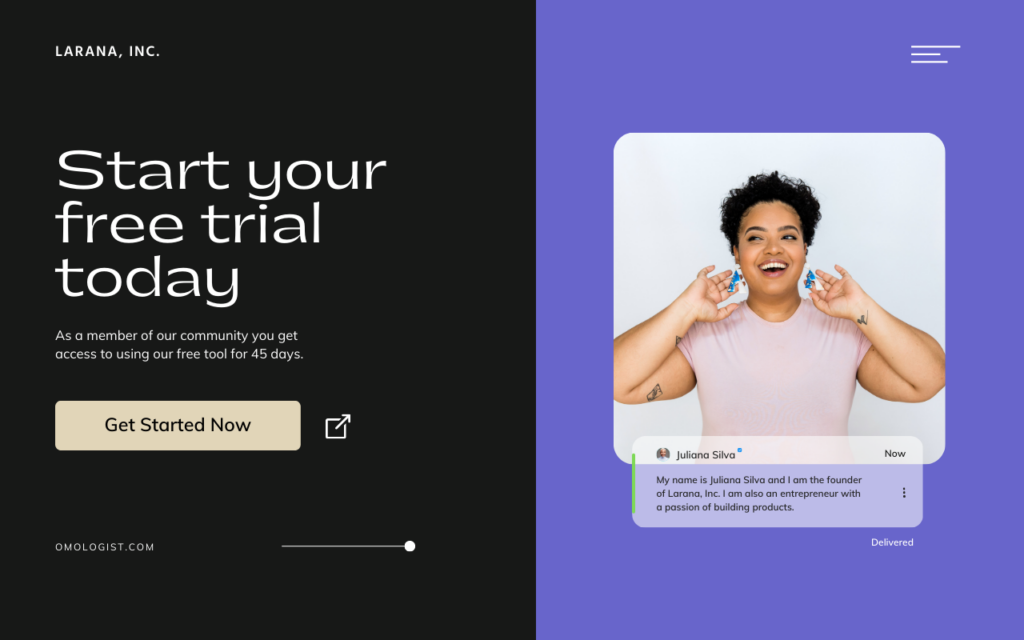
like the design, check out https://www.canva.com/p/onuohaui/
Showcase Instant Gratification
Instant gratification is a psychological phenomenon that makes the audience seek immediate satisfaction or reward from the desired action. The importance of instant gratification for CTAs lies in its ability to appeal to the audience’s impatience, curiosity, or desire, making them more likely to take action immediately.
How to showcase instant gratification in your CTAs
To showcase instant gratification in your CTAs, consider the following based on your marketing goal, audience, and offer:
– Highlight the immediacy of your offer, focusing on how quickly the audience can benefit from it.
– Emphasize the convenience of your product or service, showcasing how it saves time or effort.
– Use exclusivity to make your audience feel special or privileged, tapping into their desire for uniqueness.
Examples of CTAs that showcase instant gratification include:
– Get it now “Get your free report and improve your performance in minutes”
– Access instantly “Access our premium content instantly when you sign up”
– Be the first to know “Be the first to know about our latest deals and promotions”
How to avoid showcasing unrealistic or excessive instant gratification in your CTAs
To avoid showcasing unrealistic or excessive instant gratification in your CTAs that can backfire or damage your reputation, consider the following:
– Avoid using false or exaggerated promises that cannot be delivered or create unrealistic expectations.
– Be clear and specific about the terms and conditions of your offer, avoiding ambiguity or confusion.
– Ensure that the rewards you promote are relevant and proportional to the action required from your audience.
Examples of CTAs that showcase unrealistic or excessive instant gratification include:
– Change your life today “Change your life today with our miracle product”
– Get everything you want “Get everything you want in life with our success formula”
– Win a million dollars “Win a million dollars with just one click”
Examples of instant gratification-focused CTAs:
– Get “Get your free report and improve your performance in minutes”
– Download “Download our app and start saving money today”
– Watch “Watch our video and get inspired right now”
– See “See how we helped our clients and what they say about us instantly”
– Learn “Learn from the best and enrol in our online course for immediate access”
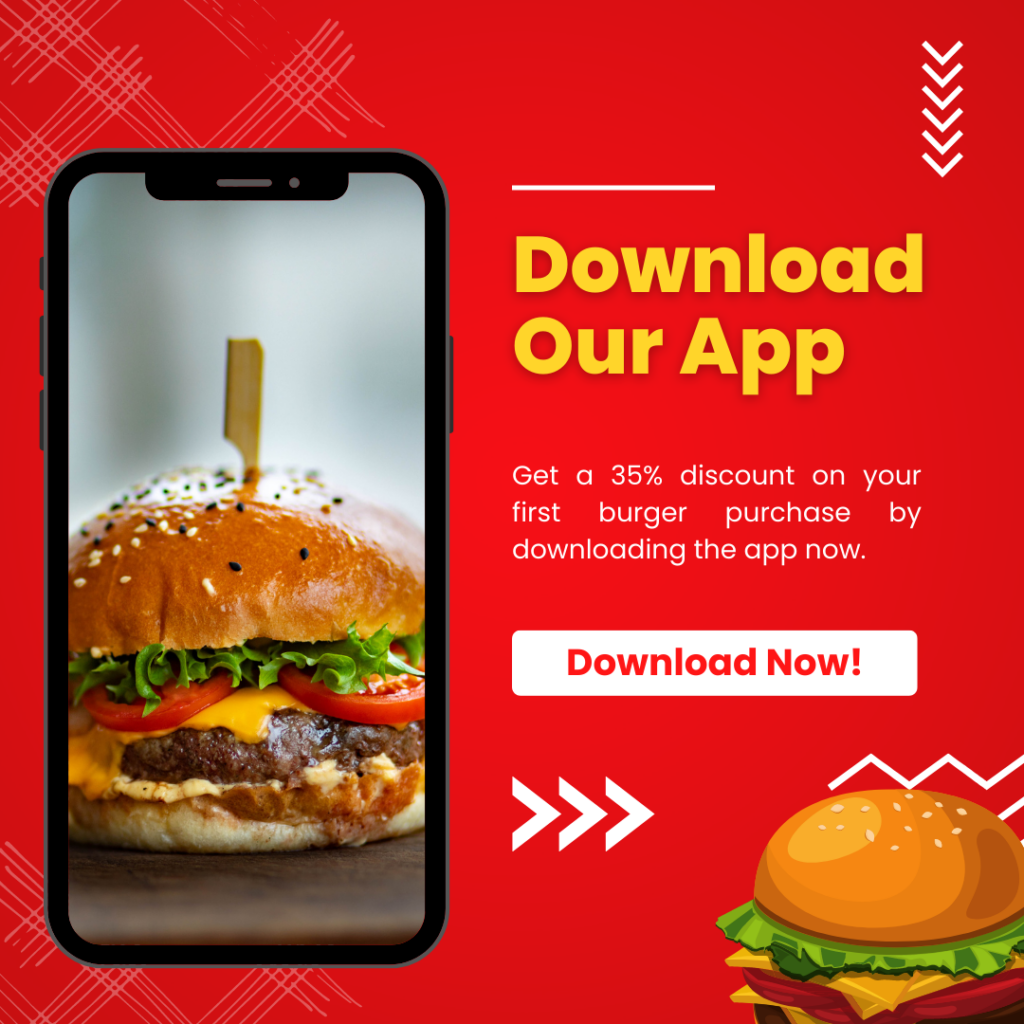
If you like this design, check out https://www.canva.com/p/streakside/
Tips for Success
Be Specific and Clear
Specificity and clarity are essential qualities of effective CTAs, as they ensure that your message is precise, accurate, and easy to understand. By being specific and clear, you can communicate your message effectively, avoid confusion or misunderstandings, and ultimately increase trust and credibility with your audience.
How to be specific and clear in your CTAs
To be specific and clear in your CTAs, consider the following tips:
Use simple and straightforward language: Choose words that are easy to understand and avoid jargon or technical terms that might confuse your audience.
Be concise: Keep your CTAs brief and to the point, making it easy for your audience to grasp your message quickly.
Focus on a single action: Avoid trying to convey multiple messages or make multiple calls for actions in a single CTA. Instead, focus on one primary action you want your audience to take.
Include relevant details: Provide the necessary information about your offer, such as price, features, benefits, or deadlines, to help your audience make an informed decision.
Avoid ambiguity: Ensure that your CTA leaves no room for interpretation, so your audience knows exactly what they need to do and what to expect.
Examples of specific and clear CTAs:
“Sign up for our newsletter and receive a 10% discount on your first purchase”
“Download our free ebook and learn the top 5 strategies for growing your business”
“Join our webinar on April 30th at 3 pm EST to discover the latest digital marketing trends”
By incorporating specificity and clarity into your CTAs, you can effectively communicate your message, reduce confusion, and build trust with your audience, leading to higher conversion rates and better overall results.
Use A/B Testing to Test CTAs
A/B testing is a valuable method for optimizing your CTAs and improving your marketing efforts. By testing different variants of your CTAs, you can make data-driven decisions to enhance conversion rates, optimize user behaviour, and ultimately increase revenue.
Here’s a step-by-step guide on how to use A/B testing to test your CTAs:
1. Identify the goal and hypothesis of your call to action test: Begin by setting a clear goal for your test, such as increasing clicks, sign-ups, or purchases. Establish a hypothesis about which call to action variant will be more effective in achieving the desired outcome.
2. Choose the best call to action variable and create two variants (A and B): Select a single variable to test, such as wording, placement, colour, or design of your call to action. Create two versions of the call to action, with one featuring the original design (Variant A) and the other featuring the modified design (Variant B).
3. Split your audience into two groups: Divide your target audience into two equal groups. To maintain the integrity of your test, ensure that the groups are randomly selected and have similar demographic and behavioural characteristics.
4. Expose the groups to either variant A or B: Present each group with one of the two call to action variants. For example, group one receives Variant A, while group two receives Variant B. Ensure that the exposure is consistent across both groups to minimize external factors affecting the test.
5. Measure the performance of your call-to-action variants: Track relevant metrics such as click-through rate, conversion rate, or revenue generated by each variant. Collect data over a predetermined time frame or until you achieve a statistically significant sample size.
6. Analyze the results and determine which call to action variant is more effective: Compare the performance of both variants and determine which one produced better results. If the difference in performance is statistically significant, consider implementing the more more effective call to action variant in your marketing campaign.
7. Iterate and optimize: A/B testing is an ongoing process. Continue to test new variables and refine your CTAs based on your findings. This iterative approach will help you optimize your marketing efforts and maximize the effectiveness of your CTAs.
By using A/B testing to test your CTAs, you can make data-driven decisions that lead to higher conversion rates, optimized user behaviour, and increased revenue for your business.
Strategic Placement of CTAs
Strategic placement of CTAs refers to choosing the optimal location and timing for your CTAs on your website or content. This ensures maximum visibility, relevance, and effectiveness of your CTAs, ultimately leading to higher conversion rates and better user engagement.
Benefits of strategic placement of CTAs for marketing
Strategically placing your CTAs can result in several benefits for your marketing efforts, including:
1. Increased visibility: Placing CTAs in prominent locations increases their visibility, making it more likely for users to notice and interact with them.
2. Enhanced relevance: By placing CTAs contextually within your content, you can make them more relevant and appealing to your audience.
3. Improved effectiveness: Optimizing the placement of CTAs can lead to higher engagement rates and, ultimately, better conversion rates.
Examples of strategic placement of CTAs in marketing
Some examples of strategic placement of CTAs include:
1. Above the fold: Place CTAs near the top of the webpage, ensuring they are visible without scrolling.
2. Below the fold: Positioning CTAs further down the landing page, where users might be more engaged and ready to take action.
3. In the sidebar: Utilizing the sidebar of your website to display CTAs, making them consistently visible as users scroll through the content.
4. At the end of the content: Placing CTAs at the conclusion of an article or blog post, where users have finished reading and might be more inclined to take action.
How to use strategic placement of CTAs for marketing
To effectively use the strategic placement of CTAs in your marketing efforts, follow these steps:
1. Identify your goal and audience for your call to action: Determine the primary objective of your call to action increasing awareness, engagement, or conversion) and understand the characteristics and preferences of your target audience.
2. Choose the type and format of your call to action: Based on your goal and audience, select the most suitable type and format for your CTA, such as text, image, video, or interactive elements.
3. Place your call to action where it is most likely to catch the attention and interest of your audience: Consider placing your CTA near the headline, in the middle of the content, or after a testimonial, depending on what best suits your audience’s behaviour and preferences.
4. Test and optimize your call to action placement: Utilize analytics tools to track the performance of your CTAs in different locations. Collect feedback from your audience and make data-driven decisions to optimize the placement of your CTAs.
By strategically placing your CTAs, you can significantly improve their visibility, relevance, and effectiveness, ultimately leading to better marketing results and higher conversion rates.
Writing effective CTAs for various platforms
CTAs for Social Media
To write effective CTAs for social media, consider the following tips:
1. Use catchy phrases: Utilize short and attention-grabbing phrases that encourage users to take action.
2. Include emojis: Emojis can add personality and emotion to your CTAs, making them more engaging and relatable.
3. Incorporate hashtags: Hashtags can help your CTAs become more discoverable and connected to relevant conversations.
4. Pose questions: Asking questions can prompt users to interact with your content and share their opinions.
CTAs for Ads
To create effective CTAs for ads, consider these tips:
1. Use specific numbers: Incorporate numbers to quantify the value of your offer and make it more appealing.
2. Provide statistics: Share relevant data or statistics to support your claims and increase credibility.
3. Highlight testimonials: Include customer testimonials or reviews to showcase social proof and build trust.
4. Keep it concise: Ensure your CTA text is brief and to the point, as ads typically have limited space.
CTAs for Emails
To write impactful CTAs for emails, keep these tips in mind:
1. Craft compelling subject lines: Encourage recipients to open your email by creating a captivating and relevant subject line.
2. Use strong headlines: Include a powerful headline within the email to draw readers in and maintain their attention.
3. Optimize email signatures: Add a clear CTA in your email signature to encourage further action without overwhelming the reader.
4. Focus on personalization: Tailor your CTAs to the recipient’s preferences or interests to increase engagement.
CTAs for Websites
When writing CTAs for websites, consider the following recommendations:
1. Use contrasting colours: Choose colours that stand out against the background and grab the user’s attention.
2. Experiment with shapes: Test different button shapes to find the most visually appealing and effective design for your CTA buttons.
3. Choose readable fonts: Opt for clear and easy-to-read fonts that align with your brand identity.
4. Prioritize placement: Strategically place CTAs in prominent locations on your website to maximize visibility and engagement.
By tailoring your CTAs to the specific characteristics and requirements of each platform, you can optimize their effectiveness and drive better results for your marketing campaigns.
Tailoring CTAs for different industries
Tailoring your call to action for different industries involves adapting your CTA to suit the specific characteristics, needs, and preferences of your target market in a particular industry. This approach offers several benefits, such as increasing relevance, trust, and conversion of your CTA.
How to tailor your CTA for different industries
1. Identify your target market and industry: Research your audience’s pain points, goals, and expectations to better understand their needs and preferences.
2. Choose the best CTA examples, type and format: Select the appropriate format for your target market and industry, such as text, image, video, or interactive.
3. Write your CTA copy: Use words and phrases that resonate with your target market and industry, such as industry-specific jargon, acronyms, or slang.
4. Design your CTA element: Utilize colours, shapes, and fonts that match your target market and industry’s preferences and associations.
Examples of tailored CTAs for different industries
Travel: “Discover our top-rated destinations and save 30% on your booking.” This CTA highlights a benefit and uses industry-specific language.
Education: “Unlock your potential with our online courses – start now!” This CTA offers a value proposition and motivation to take action.
Finance: “Apply for our low-interest loan and secure your financial future.” This CTA uses clear language and highlights a financial benefit.
Health: “Experience personalized workouts with our fitness app – free trial!” This CTA offers a customized solution and a risk-free trial.
E-commerce: “Upgrade your wardrobe – shop now and enjoy 15% off your first purchase.” This CTA uses a benefit and an incentive to encourage action.
Real estate: “Find the perfect commercial property – contact our experts today.” This CTA appeals to the audience’s needs and establishes credibility.
Software: “Boost your productivity with our software – try it free for 30 days.” This CTA highlights the benefit and offers a risk-free trial.
Legal: “Protect your rights – schedule a free consultation with our experienced attorneys.” This call to take action immediately establishes authority and offers a free service.
Nonprofit: “Support our cause and help create a better world – donate now.” This CTA uses an action verb and emphasizes the positive impact.
Entertainment: “Experience the magic of our live show – buy tickets today!” This CTA provides an enticing experience and encourages quick action.
By tailoring your CTAs to different industries, you can increase their relevance and effectiveness, ultimately driving better results for your marketing campaigns.
What is a social media call to action, and its importance in marketing
A social media call to action (CTA) is a short phrase, or sentence that prompts your audience to take a specific action on your social media posts or profiles. The benefits of using a social media CTA in marketing include increased engagement, traffic, leads, and conversions.
Examples of social media CTAs include “like,” “comment,” “share,” “follow,” “click,” or “buy.”
General Principles of Writing a Great Social Media Call to Action
1. Use action verbs and words that create a sense of urgency, curiosity, or emotion: Words that evoke emotion or urgency can motivate your audience to take action.
2. Address the audience directly using “you” or “your” and personalize your message based on their needs and interests: Personalizing your call to action makes it more relatable and appealing to your audience.
3. Include a clear and easy way for the audience to respond or take the next step, such as a button, link, or hashtag: Make it simple for your audience to understand what action they need to take.
4. Keep it simple, concise, and consistent with your brand voice and tone: A clear and concise CTA that aligns with your brand will be more memorable and impactful.
Writing a great social media call to action for different platforms
Facebook: Use emojis, questions, or polls to spark engagement and interaction. For example, “What’s your favourite summer activity? Share in the comments below! 😎🌞”
Twitter: Use hashtags, mentions, or retweets to increase reach and visibility. For example, “Share your favourite productivity tip using #ProductivityHacks, and we’ll retweet the best ones!”
Instagram: Use stories, stickers, or filters to create fun and interactive experiences. For example, “Swipe up to check out our latest blog post and let us know what you think using the ‘Question’ sticker in our Instagram Story!”
LinkedIn: Use statistics, testimonials, or case studies to showcase your value and credibility. For example, “Our clients have seen a 35% increase in sales using our software. Click the link to read their success stories and learn more.”
TikTok: Use engaging video content, captions, and soundtracks to encourage users to interact with your content. For example, “Join our #DanceChallenge and show off your moves! 💃🕺
Don’t forget to tag us and use the hashtag for a chance to be featured on our page!”
By applying these principles and tailoring your social media CTAs to each platform, you can effectively engage your audience and drive desired actions.
How to measure and improve your CTA performance and results
Measure call to action performance: To measure the performance of your CTAs, track key metrics such as click-through rate (CTR), conversion rate, and bounce rate. Use analytics tools like Google Analytics to gather data and insights on user behaviour and engagement with your CTAs.
Improve call to action performance: Analyze the data from your analytics tools to identify areas where your CTAs can be improved. Pay attention to factors such as low call to action, high bounce rates, and low conversion rates. This can help you understand if your CTA is not engaging enough, if it is placed in a less visible location, or if it is not resonating with your audience.
A/B testing: Conduct A/B tests to experiment with different call-to-action variations, such as different colours, button shapes, text, or placement. By comparing the performance of each variation, you can determine which one works best for your audience and optimize your CTAs accordingly.
Feedback: Collect feedback from your audience through surveys, user testing, or direct conversations. This can provide valuable insights into their preferences and pain points, helping you improve your CTAs to better address their needs.
Examples of improved CTAs:
1. Original CTA: “Subscribe now”
Improved call to action: “Subscribe now and get 10% off your first order!” (Increased urgency and offered an incentive for subscribing)
2. Original CTA: “Learn more”
Improved call to action: “Discover our 5-step plan to boost your productivity” (More specific and focused on the value proposition)
3. Original CTA: “Buy now” (placed at the bottom of the page)
Improved call to action: “Buy now” (placed above the fold, making it more visible and accessible)
Common Mistakes in CTAs
1. Using too many call to actions
Overloading a web page or email with multiple CTAs can confuse or overwhelm your audience, making it difficult for them to understand which action they should take. This can lead to decision paralysis and reduce the overall effectiveness of your marketing message.
Examples of how to fix too many CTAs
1. A web page with multiple CTAs such as “Subscribe”, “Download the eBook”, “Contact Us”, and “Start a Free Trial” all placed close together can be confusing for the user. To improve this, you can prioritize the most important call to action, such as “Start a Free Trial”, and place it prominently on the page. The other CTAs can be placed in less prominent locations or spread throughout the content.
2. An email with several CTAs like “Read the Blog Post”, “Share on Social Media”, “Sign Up for Our Webinar”, and “Buy Now” can overwhelm the reader. To improve this, focus on a single primary call to action, such as “Sign Up for Our Webinar”, and include secondary CTAs in a less prominent manner, like placing them at the end of the email or in the footer.
Guidelines and best practices:
1. Prioritize your CTAs: Determine the most important action you want your audience to take and prioritize that call to action in your design and content.
2. Limit the number of CTAs: Stick to one primary call to action per page or email, and if necessary, include secondary CTAs in a less prominent manner.
3. Use clear visual hierarchy: Design your primary call to action to stand out from the rest of the content, while secondary CTAs should be less prominent.
4. Spread CTAs throughout the content: Instead of placing all CTAs together, distribute them strategically to avoid overwhelming your audience. For example, include a call to action at the end of a relevant section or after providing valuable information.
5. Test and optimise: Use analytics and A/B testing to evaluate the performance of your CTAs and make adjustments as needed to improve their effectiveness.
2. Using too few CTAs
Not including enough CTAs in your content can cause you to miss opportunities for audience engagement and conversion. If your audience is unsure of what to do next or how to take action, they may leave your website or ignore your various email campaigns, resulting in lost potential leads and sales.
Examples of using too few CTAs and how to fix.
1. A web page with a lengthy article and no call to action can leave the reader uncertain about what to do after finishing the content. To improve this, you can add a call to action at the end of the article encouraging the reader to subscribe for more content or download a related resource.
2. An email with only a single “Learn More” call to action at the very end might not be noticed or clicked by the reader. To improve this, consider adding another call to action higher up in the email or using visual cues to draw attention to the call to action.
Guidelines and best practices:
1. Assess your content: Review your web pages and emails to ensure they have at least one clear and relevant CTA, guiding the audience toward the next step you want them to take.
2. Strategically place CTAs: Position your CTAs where they are most likely to be noticed and clicked, such as above the fold on a web page, within the body of an email, or at the end of a content piece.
3. Use multiple CTAs for long content: For lengthy web pages or emails, consider using more than one CTA, placed at logical points throughout the content, to ensure your audience doesn’t miss the opportunity to engage.
4. Match CTAs to audience intent: Ensure your CTAs align with the goals or interests of your target audience. For example, if you have a blog post about a specific topic, include a CTA to download a related eBook or sign up for a relevant webinar.
5. Test and optimise: Continuously evaluate the performance of your CTAs using analytics and A/B testing to identify areas for improvement and ensure your audience is given appropriate opportunities to take action.
3. Using too long or too short a Call to action
CTAs that are either too lengthy or too brief can negatively impact the readability and clarity of your message. Overly long CTAs may overwhelm or confuse your audience, while extremely short CTAs might lack sufficient information to motivate the audience to take action.
Examples on how to improve a long or short CTA
1. A call to action like “Click here if you want to find out more about our amazing product that will change your life and help you achieve your goals” is too long and convoluted. To improve this, you could shorten it to “Discover how our product can change your life”.
2. A call to action that simply says “Click” is too short and vague, providing no context or reason for the audience to engage. To improve this, you could expand it to “Click to learn more about our services”.
Guidelines and best practices:
1. Be concise but informative: Aim for a CTA that is brief yet provides enough information to convey the value or benefit of taking action. A general rule of thumb is to use between two and seven words for a CTA.
2. Focus on action verbs: Start your CTA with a strong action verb that tells the audience exactly what to do, such as “download,” “Subscribe,” “register,” or “buy.”
3. Highlight the benefit: Clearly communicate the advantage of taking action, so your audience understands what they will gain by clicking your CTA, like “Get your free guide” or “Save 20% now.”
4. Test and optimise: Use A/B testing to compare the performance of CTAs with different lengths and wordings. This will help you identify the optimal length and phrasing for your target audience and specific campaign goals.
5. Adapt to the platform: Consider the constraints and characteristics of the platform where your CTA will appear. For example, a shorter CTA might be more suitable for social media platforms with limited character counts, while a slightly longer CTA could work better in an email or on a web page.
4. Using generic or boring CTAs
Generic or dull CTAs often fail to capture the attention and interest of your audience, as they do not stand out or differentiate your brand or offer from competitors. This can lead to lower engagement and conversion rates.
Examples of how to improve a boring CTA
1. A CTA like “Click here” is too generic and uninteresting. To improve this, you could use a more specific and engaging phrase, such as “Discover our exclusive deals.”
2. A CTA that simply says “Submit” is boring and does not provide any context or incentive. To improve this, you could make it more appealing, like “Get my personalized report.”
Guidelines and best practices:
1. Focus on value and benefits: Emphasize the unique value proposition or benefit your audience will receive by taking action, such as “Unlock your secret discount” or “Join our VIP club for exclusive perks.”
2. Be creative and use powerful words: Make your call to action stands out by using creative and attention-grabbing words or phrases, such as “instantly,” “exclusive,” “limited time,” “risk-free,” or “guaranteed.”
3. Use personalization: Personalize your CTAs based on your audience’s interests, preferences, or demographics to make them more relevant and engaging, like “Find your perfect workout plan” or “Explore vegan recipes.”
4. Consider your brand voice and tone: Align your call to action with your brand’s personality and tone, whether professional, casual, humorous, or inspirational. This can help reinforce your brand identity and create a stronger connection with your audience.
5. Test and optimise: Use A/B testing to experiment with different CTAs to determine which phrases and styles resonate best with your target audience and achieve your desired results. This will help you refine your messaging and create more effective CTAs over time.
6. Adapt to the platform: Keep the platform’s specific audience and context in mind when crafting your call to action. For instance, use casual language on social media platforms, while maintaining a professional tone on LinkedIn or business websites.
Using ChatGPT to generate ideas
Below is a Chat GPT prompt you can use to generate ideas for each of the different types of CTAs.
To use simply copy the text below (click the copy button at the top right corner) and paste into Chat GPT. Once you click to run the prompt it will ask you want the product or service (topic) is that you want to advertise on Google Ads. Just type in your topic and push enter.
The results will provide you two examples of each of the different types of CTAs based on your topic.
The results will also be analysed and three suggestions made with analysis as to why they were picked.
Please use this only as a guide to generating ideas.
I want you to act as a Google Ads copywriter.
Before continuing, ask for the topic you want to write the Google ads copy for, and then use the answer in the prompt when you see [topic]
Here is a list of the different types of CTA we want you to use
Use Strong Action words
Evoke an emotional response
Include no-obligation statements
Leverage curiosity
Leverage problem solving
Leverage the urge to belong
Provoke Emotion
Provoke Enthusiasm
Offer something of value
Create a sense of urgency
Utilise Fear of missing out
Focus on the benefits
Use numbers in the CTA
Sell the trial
Showcase Instant gratification
Your now going to create two lists in a table format.
The first list should contain 30 attention-grabbing headings on the topic of [topic], two for each type of CTA listed above - each heading should have 30 characters maximum, including spaces.
Display this list in a table format showing the type of CTA in Column 1 and Heading in Column 2. Remember no more than (30 characters max, including spaces)
The column heading should say "Headlines"
List two should contain 30 concise descriptions on the topic of [topic] using the same types of CTA as listed.
Each description should contain (90 characters max, including spaces.)
Display this list in a table format.
The column heading should say "Descriptions"
After you have created the headline and description list.
You will list 3 Headlines (max. 30 characters) and 3 descriptions, 90 characters max that you feel work the best together.
This column heading will say, "Three suggested headlines and descriptions and why"
Analyse the headlines and descriptions and choose the 3 best headings and descriptions and provide some analysis as to why you chose these.
List these in the following format
1
2
3
Add the following statement at the bottom of the table - “Please use these ideas as a guide for each CTA type and for ideas on how to execute each type of CTA”
Example 1 - Product - Frank Green water bottles

Example 2 - Service - plumber

Additional reading
Other than lots of articles on the web with examples, here is a little more meaty reading.
Schwartz, E. (2004). Breakthrough Advertising. Bottom Line Books. https://www.amazon.com/Breakthrough-Advertising-Eugene-M-Schwartz/dp/0887232981/
Breakthrough Advertising is a classic book on copywriting and marketing by Eugene Schwartz, one of the most influential and successful copywriters of the 20th century. The book reveals the secrets of writing persuasive and effective ads that sell any product or service. It covers topics such as how to understand the market, how to identify the stages of awareness and sophistication of the prospects, how to craft powerful headlines and body copy, how to appeal to different emotions and desires, how to test and improve your ads, and more. The book is full of examples and insights from Schwartz’s own experience and research, as well as from other legendary copywriters and marketers. It is a must-read for anyone who wants to master the art and science of copywriting and advertising.
Kennedy, D., & Walsh-Phillips, K. (2017). No B.S. Guide To Direct Marketing: The Ultimate No Holds Barred Kick Butt Take No Prisoners Direct Marketing For Non-Direct Marketing Businesses (3rd ed.). Entrepreneur Press. https://www.amazon.com/Guide-Direct-Response-Social-Marketing/dp/B08BLX5166/
No B.S. Guide To Direct Marketing is a practical and proven guide to creating and implementing direct marketing campaigns that generate leads, sales, and profits. The book is written by Dan Kennedy, a legendary copywriter and marketer, and Kim Walsh-Phillips, a social media expert and CEO of Elite Digital Group. The book shows how to combine the power of direct response marketing with the reach and influence of social media to create a winning formula for any business. The book covers topics such as how to identify your ideal target market, how to craft irresistible offers and headlines, how to write persuasive copy and design effective ads, how to use Facebook, Twitter, LinkedIn, YouTube, and other platforms to generate traffic and leads, how to track and measure your results, and more. The book is filled with action examples below, case studies, templates, checklists, and resources that make it easy to apply the strategies and tactics to your own business.
Rappaport, A., & Halevi, T. (2018). Dollarizing Differentiation Value: A Practical Guide for the Quantification and the Capture of Customer Value. World Scientific Publishing Company. https://www.amazon.com/Dollarizing-Differentiation-Value-Practical-Quantification-ebook/dp/B01LOO1G6W/
This book explains how marketers can quantify and communicate the value of their products or services to their customers in terms of dollars. It provides a step-by-step method for dollarizing differentiation value, which is the economic value of any difference in performance or cost between alternatives. It also shows how to use this method to create powerful calls to action that persuade customers to buy.
